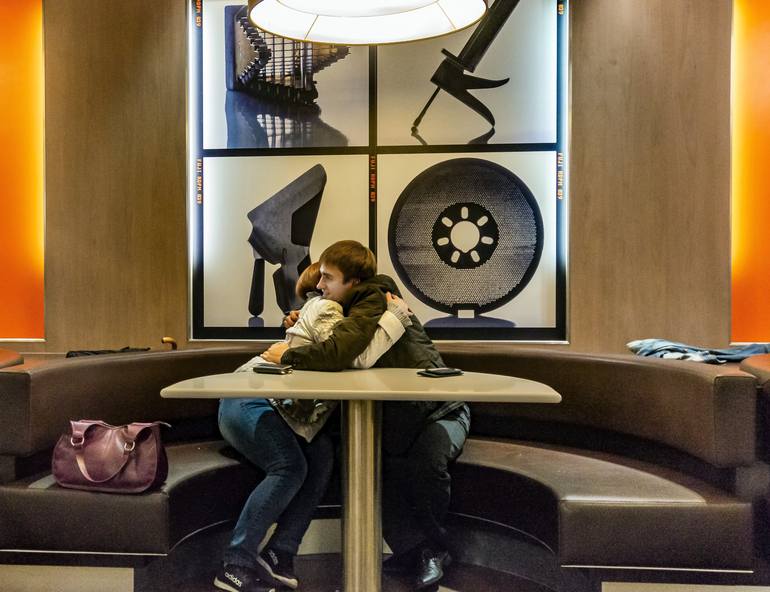


84 Views
1
View In My Room
Photography, Color on Paper
Size: 91.4 W x 70.4 H x 0.3 D cm
Ships in a Tube
84 Views
1
Artist Recognition

Artist featured in a collection
ABOUT THE ARTWORK
DETAILS AND DIMENSIONS
SHIPPING AND RETURNS
'The Direct Descendant of My First Successful Image' This image of a Ukrainian couple in a restaurant publicly displaying their affection is a direct descendant of my first successful image, three men on a ferry boat, among the first ten images I ever took and also on display i this gallery. The...
Year Created:
2013
Subject:
Mediums:
Photography, Color on Paper
Rarity:
Limited Edition of 15
Size:
91.4 W x 70.4 H x 0.3 D cm
Ready to Hang:
Not Applicable
Frame:
Not Framed
Authenticity:
Certificate is Included
Packaging:
Ships Rolled in a Tube
Delivery Cost:
Shipping is included in price.
Delivery Time:
Typically 5-7 business days for domestic shipments, 10-14 business days for international shipments.
Returns:
The purchase of photography and limited edition artworks as shipped by the artist is final sale.
Handling:
Ships rolled in a tube. Artists are responsible for packaging and adhering to Saatchi Art’s packaging guidelines.
Ships From:
United States.
Need more information?
Need more information?
John Crosley
United States
I am a photographer who has taken in the past 12 years, over est. 2 million images, mostly street, with many shown previously under various host sites to over est. 200 million counted viewers. I practiced law very successfully in Silicon Valley, CA for nearly two decades; retiring at about age 40. I am a graduate of NYC's Columbia College, Columbia University. As editor/writer/photographer, I won the Lebhar-Friedman Publishing Blue Chip award for excellence in writing, editing, and photography. For law,I won a variety of awards and special recognition. I attended law school in Silicon Valley, graduating with honors and founding my own Silicon Valley law firm, from which I retired in the late 1980s. I have worked side by side with over a half dozen Pulitzer prize-winning photographers, was shot once, and later medically evacuated from Vietnam while photographing the war there. Self-taught in photography, later, among others, I have been mentored by the following: 1. Henri Cartier-Bresson 2. Sal Vader, Pulitzer winner, Associated Press 3. Wes Gallagher, President/Ceo of Associated Press who groomed me to replace him as A.P. head. 4. Sam Walton, Wal-Mart founder who tried to lure me into his smaller company, now the world's largest. retailer. 5. Walter Baring, Peabody award winner, WRVR-FM NYC's premier cultural radio station. 6./ A variety of great photographers, many Pulitzer winners, including many also from Associated Press,/ Many were Vietnam war colleagues from my freelancing the Vietnam war; others from AP NYC world headquarters. I took H C-B's advice: 'Shoot for yourself, John,' to avoid photo work that would require shooting in a special style. not my own. HCB's s generous, helpful advice also resulted in a career with AP wire service as a world news writer and editor, world service, Associated Press world headquarters, NYC. 6. Michel Karman, Lucie Award photo printer and photo exhibition genius. ent in two 'wars' -- the Vietnamese War, and a prisoner of war taken by Russian separatists in the current Ukrainian--Russian Separatist battles that killed over 10,000 and displaced over 1 million. While writing and as a worldwide photo editor for Associated Press, I was asked to understudy their CEO (worldwide General Manager), to become successor general manager on his retirement, but declined the position. I live the lifestyle of a photographer and am proud of it.
Artist Recognition

Artist featured by Saatchi Art in a collection
Why Saatchi Art?
Thousands of
5-Star Reviews
We deliver world-class customer service to all of our art buyers.
Global Selection of Original Art
Explore an unparalleled artwork selection from around the world.
Satisfaction Guaranteed
Our 14-day satisfaction guarantee allows you to buy with confidence.
Support Emerging Artists
We pay our artists more on every sale than other galleries.
